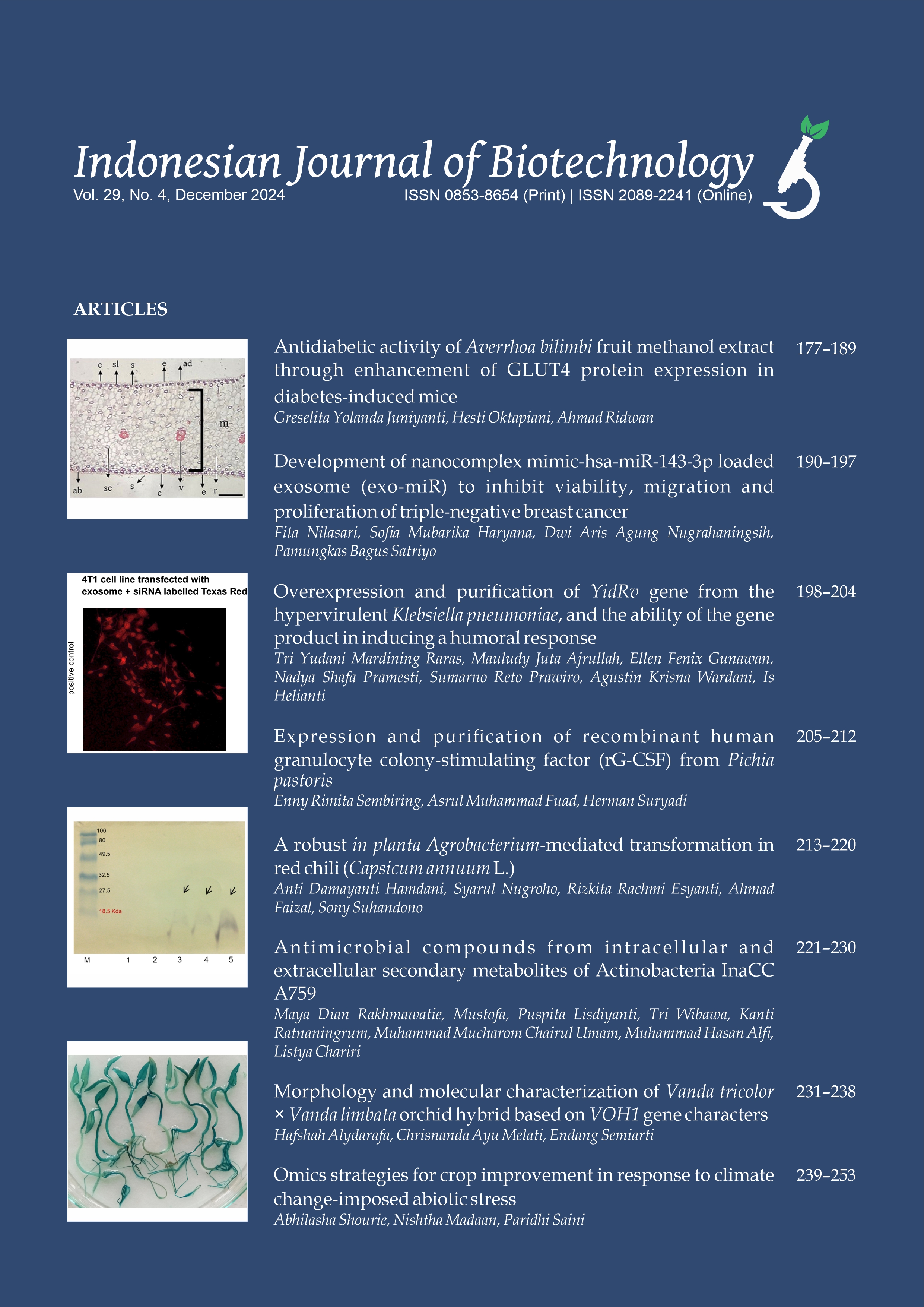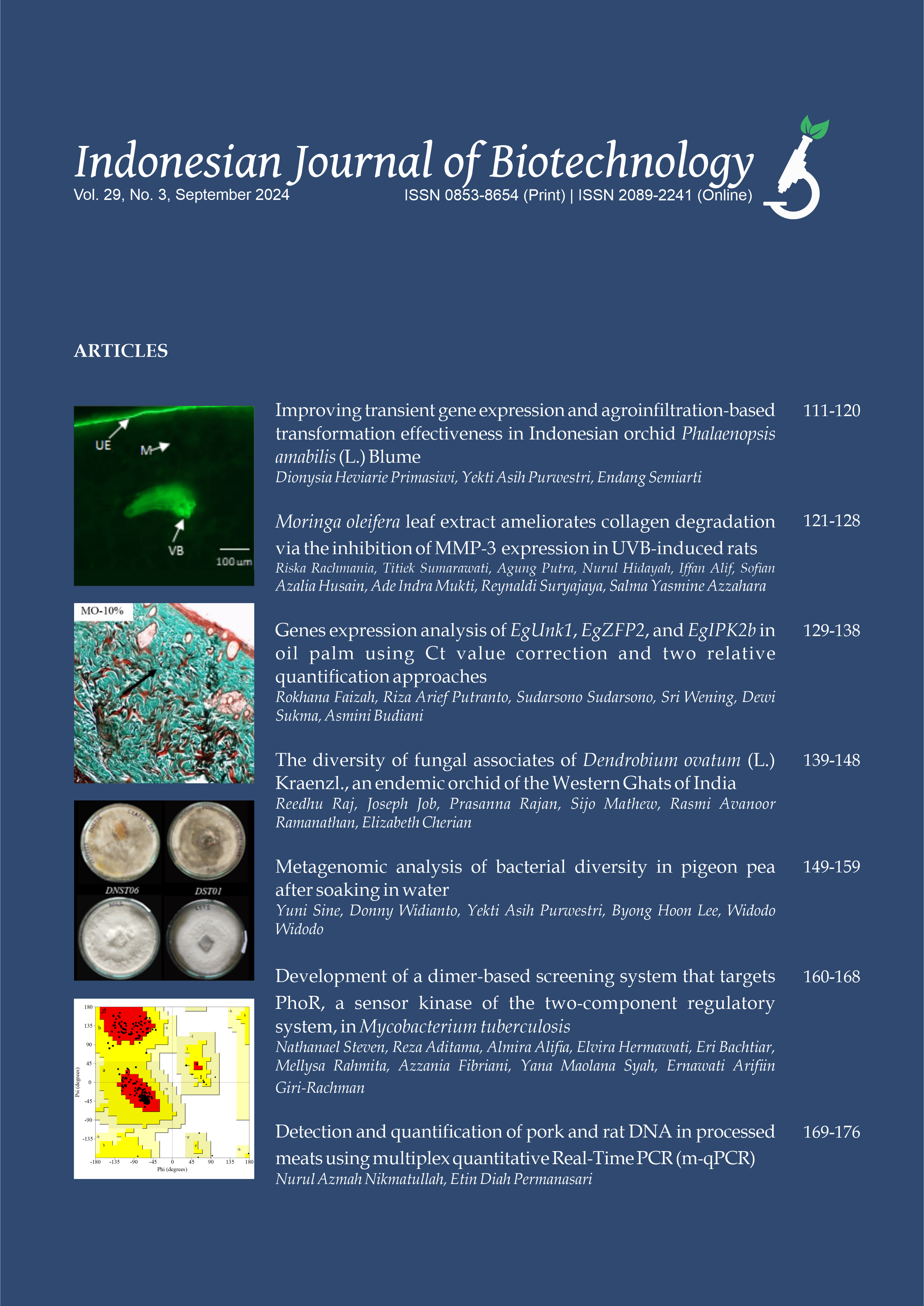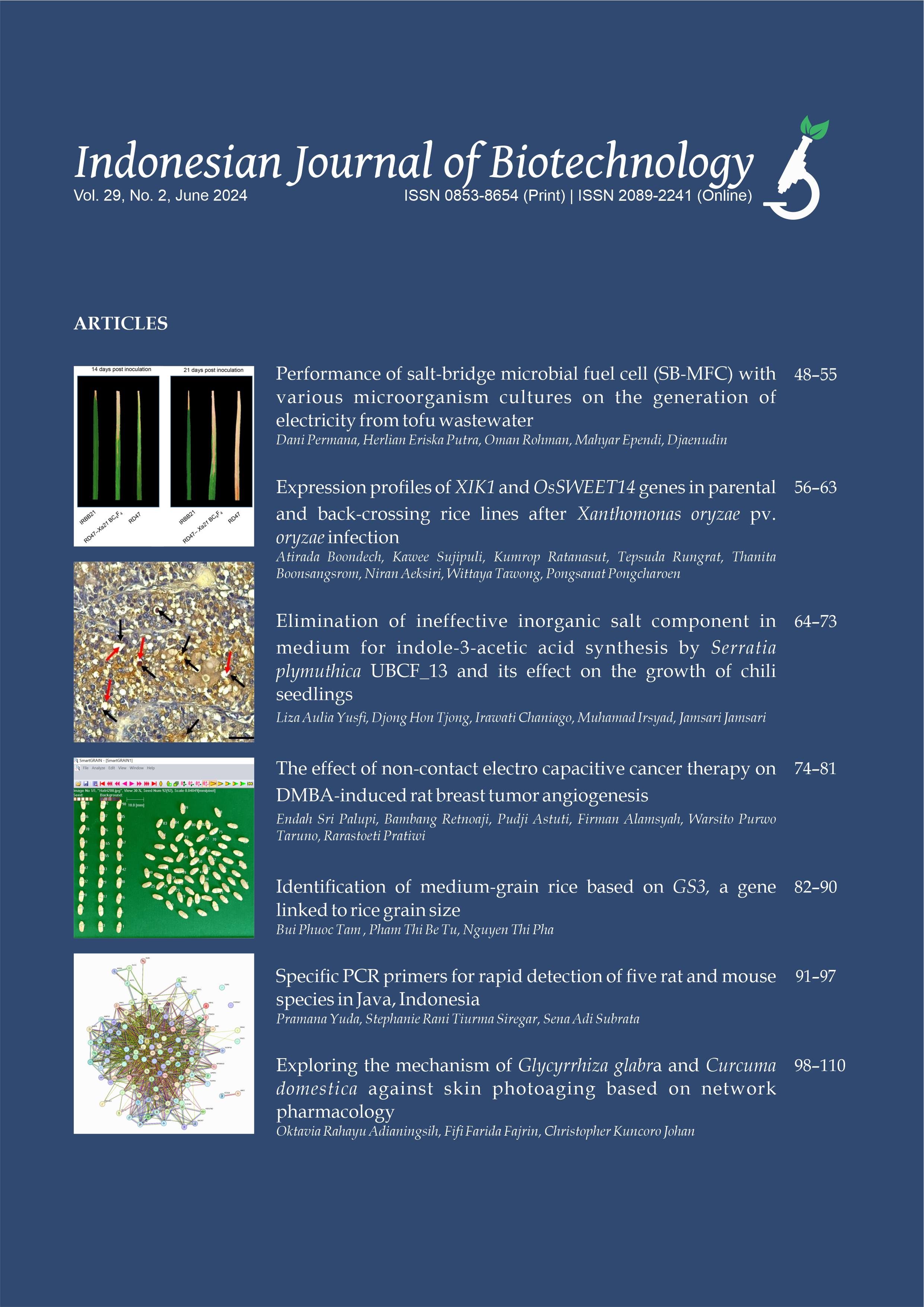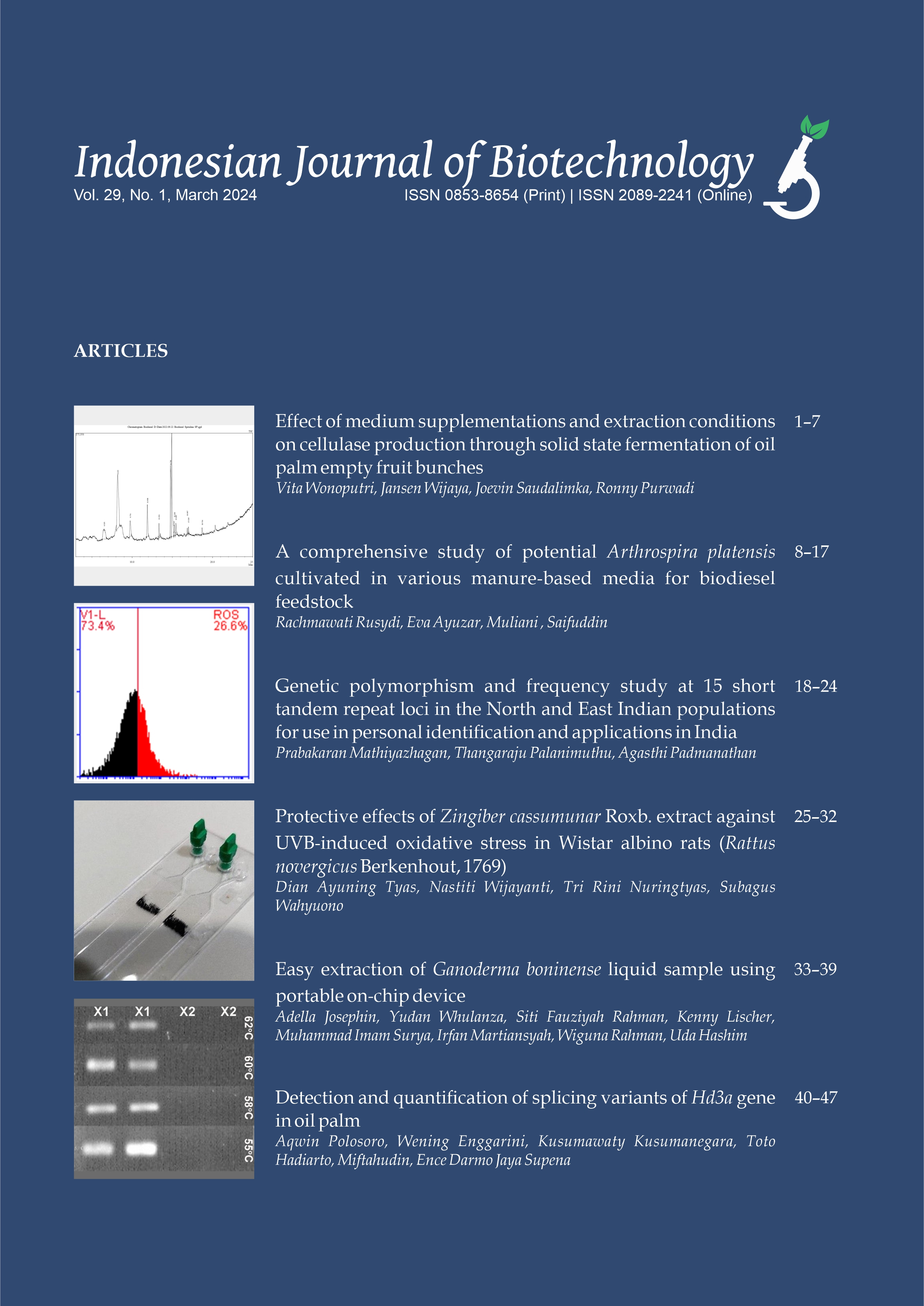Computational modeling of AGO-mediated molecular inhibition of ARF6 by miR-145
Jeremias Ivan(1), Rizky Nurdiansyah(2), Arli Aditya Parikesit(3*)
(1) Department of Bioinformatics, School of Life Sciences, Indonesia International Institute for Life Sciences, Pulomas Barat Kav 88, Jakarta Timur 13210
(2) Department of Bioinformatics, School of Life Sciences, Indonesia International Institute for Life Sciences, Pulomas Barat Kav 88, Jakarta Timur 13210
(3) Department of Bioinformatics, School of Life Sciences, Indonesia International Institute for Life Sciences, Pulomas Barat Kav 88, Jakarta Timur 13210
(*) Corresponding Author
Abstract
Inhibition of ADP-ribosylation factor 6 messenger RNA (ARF6 mRNA) by microRNA-145 (miR-145), mediated by Argonaute (AGO) protein, has been found to play essential roles in several types of cancer and cellular processes. This study aimed to model the molecular interaction between miR-145 and ARF6 mRNA with AGO protein. The sequences of miR-145 and the 3’ untranslated region (UTR) of ARF6 mRNA were retrieved from miRTarBase, followed by miRNA target-site and structure predictions were done using RNAhybrid, RNAfold, and simRNAweb, respectively. The interaction between the miRNA-mRNA duplex and AGO was further assessed via molecular docking, interaction analysis, and dynamics, using PatchDock Server, PLIP, and VMD/NAMD, respectively. The models between miR-145, predicted target site of ARF6 mRNA, and AGO protein returned stable thermodynamic variables with negative free energy. Specifically, the RNA duplex had an energy of -19.80 kcal/mol, while the docking had -84.58 atomic contact energy supported by 70 hydrogen bonds and 14 hydrophobic interactions. However, the stability of the RMSD plot was still unclear due to limited computational resources. Nevertheless, these results computationally confirm favorable interaction of the three molecules, which can be utilized for further transcriptomics-based drugs or treatments.
Keywords
Full Text:
PDFReferences
Ahirwar R, Nahar S, Aggarwal S, Ramachandran S, Maiti S, Nahar P. 2016. In silico selection of an aptamer to estrogen receptor alpha using computational docking employing estrogen response elements as aptamer alike molecules. Sci Rep. 6. doi:10.1038/srep21285.
Bellissimo T, Tito C, Ganci F, Sacconi A, Masciarelli S, Di Martino G, Porta N, Cirenza M, Sorci M, De An gelis L, et al. 2019. Argonaute 2 drives miR1455p dependent gene expression program in breast cancer cells. Cell Death Dis. 10(1). doi:10.1038/s41419018 12675.
Betel D, Wilson M, Gabow A, Marks DS, Sander C. 2008. The microRNA.org resource: Targets and expression. Nucleic Acids Res. 36(SUPPL. 1):D149–D153. doi:10.1093/nar/gkm995.
Boniecki MJ, Lach G, Dawson WK, Tomala K, Lukasz P, Soltysinski T, Rother KM, Bujnicki JM. 2015. Sim RNA: a coarsegrained method for RNA folding simulations and 3D structure prediction. Nucleic Acids Res. 44(7):e63. doi:10.1093/nar/gkv1479.
Chou CH, Shrestha S, Yang CD, Chang NW, Lin YL, Liao KW, Huang WC, Sun TH, Tu SJ, Lee WH, et al. 2018. MiRTarBase update 2018: A resource for experimentally validated microRNAtarget inter actions. Nucleic Acids Res. 46(D1):D296–D302. doi:10.1093/nar/gkx1067.
Das RP, Konkimalla VB, Rath SN, Hansa J, Jagdeb M. 2015. Elucidation of the Molecular Interaction between miRNAs and the HOXA9 Gene, Involved in Acute Myeloid Leukemia, by the Assistance of Argonaute Protein through a Computational Approach. Genomics Inform. 13(2):45. doi:10.5808/gi.2015.13.2.45.
Djuranovic S, Nahvi A, Green R. 2011. A parsimonious model for gene regulation by miRNAs. Science 331(6017):550–553. doi:10.1126/science.1191138.
Duhovny D, Nussinov R, Wolfson HJ. 2002. Efficient unbound docking of rigid molecules. In: R Guigó, D Gusfield, editors, Algorithms in Bioinformatics. WABI 2002. Lecture Notes in Computer Science, vol ume 2452. Berlin, Heidelberg: Springer. p. 185–200. doi:10.1007/3540457844_14.
Eades G, Wolfson B, Zhang Y, Li Q, Yao Y, Zhou Q. 2015. LincRNARoR and miR145 regulate invasion in triplenegative breast cancer via targeting Arf6. Mol Cancer Res. 13(2):330–338. doi:10.1158/1541 7786.MCR140251.
Hashimoto S, Onodera Y, Hashimoto A, Tanaka M, Hamaguchi M, Yamada A, Sabe H. 2004. Requirement for Arf6 in breast cancer invasive activi ties. Proc Natl Acad Sci USA 101(17):6647–6652. doi:10.1073/pnas.0401753101.
Humphrey W, Dalke A, Schulten K. 1996. VMD: Visual Molecular Dynamics. J Mol Graph. 14(1):33–38. doi:10.1016/02637855(96)000185.
Janiszewska M, Primi MC, Izard T. 2020. Cell adhesion in cancer: Beyond the migration of single cells. J Biol Chem. 295(8):2495–2505. doi:10.1074/jbc.REV119.007759.
Kandeel M, Kitade Y. 2013. Computational Analy sis of siRNA Recognition by the Ago2 PAZ Do main and Identification of the Determinants of RNA Induced Gene Silencing. PLoS ONE 8(2):e57140. doi:10.1371/journal.pone.0057140.
Li J, Kim TH, Nutiu R, Ray D, Hughes TR, Zhang Z. 2014. Identifying mRNA sequence elements for target recognition by human Argonaute proteins. Genome Res. 24(5):775–785. doi:10.1101/gr.162230.113.
Li R, Peng C, Zhang X, Wu Y, Pan S, Xiao Y. 2017. Roles of Arf6 in cancer cell invasion, metastasis and proliferation. Life Sci. 182. doi:10.1016/j.lfs.2017.06.008.
Li R, Shen Q, Wu N, He M, Liu N, Huang J, Lu B, Yao Q, Yang Y, Hu R. 2018. MiR145 improves macrophage mediated inflammation through targeting Arf6. Endocrine 60(1):73–82. doi:10.1007/s1202001815218.
Liu H, Lei C, He Q, Pan Z, Xiao D, Tao Y. 2018. Nuclear functions of mammalian MicroRNAs in gene regulation, immunity and cancer. Mol Cancer 17(1):1–14. doi:10.1186/s1294301807655.
Lorenz R, Bernhart SH, Höner zu Siederdissen C, Tafer H, Flamm C, Stadler PF, Hofacker IL. 2011. Vienna RNA Package 2.0. Algorithms Mol Biol. 6(1). doi:10.1186/17487188626.
Lorenz R, Luntzer D, Hofacker IL, Stadler PF, Wolfinger MT. 2016. SHAPE directed RNA folding. Bioinformatics 32(1):145–147. doi:10.1093/bioinformatics/btv523.
MacKerell Jr A. 2001. Atomistic Models and Force Fields. In: rO Becke, rA MacKerrel J, B Roux, M Watanabe, editors, Computational biochemistry and biophysics. New York: Marcel Dekker, Inc. p. 7–38.
Magnus M, Boniecki MJ, Dawson W, Bujnicki JM. 2016. SimRNAweb: a web server for RNA 3D structure modeling with optional restraints. Nucleic Acids Res. 44(W1):W315–W319. doi:10.1093/nar/gkw279.
Mrozik KM, Blaschuk OW, Cheong CM, Zannettino ACW, Vandyke K. 2018. Ncadherin in cancer metas tasis, its emerging role in haematological malignancies and potential as a therapeutic target in cancer. BMC Cancer 18(1):1–16. doi:10.1186/s12885018 48450.
Oh ES, Seiki M, Gotte M, Chung J. 2012. Cell adhesion in cancer. Int J Cell Biol. 2012:965618. doi:10.1155/2012/965618.
Pashaei E, Guzel E, Ozgurses ME, Demirel G, Aydin N, Ozen M. 2016. A MetaAnalysis : Identification of Common Mir145 Target Genes that have Simi lar Behavior in Different GEO Datasets. PLoS ONE 11(9):e0161491. doi:10.1371/journal.pone.0161491.
Phillips JC, Braun R, Wang W, Gumbart J, Tajkhorshid E, Villa E, Chipot C, Skeel RD, Kalé L, Schulten K. 2005. Scalable molecular dynamics with NAMD. J Comput Chem. 26(16):1781–1802. doi:10.1002/jcc.20289.
Rath SN, Das D, Konkimalla VB, Pradhan SK. 2016. In Silico Study of miRNA Based Gene Regulation, Involved in Solid Cancer, by the Assistance of Argonaute Protein. Genomics Inform. 14(3):112–124. doi:10.5808/GI.2016.14.3.112.
Rehmsmeier M, Steffen P, Hochsmann M, Giegerich R. 2004. Fast and effective prediction of mi croRNA/target duplexes. RNA 10(10):1507–1517. doi:10.1261/rna.5248604.
Sabe H. 2003. Requirement for Arf6 in Cell Adhesion, Migration, and Cancer Cell Invasion. J Biochem. 134(4):485–489. doi:10.1093/jb/mvg181.
Salentin S, Schreiber S, Haupt VJ, Adasme MF, Schroeder
M. 2015. PLIP: Fully automated proteinligand inter action profiler. Nucleic Acids Res. 43(W1):W443– W447. doi:10.1093/nar/gkv315.
SchneidmanDuhovny D, Inbar Y, Nussinov R, Wolf son HJ. 2005. PatchDock and SymmDock: Servers for rigid and symmetric docking. Nucleic Acids Res. 33(SUPPL. 2):W363–W367. doi:10.1093/nar/gki481.
Tsai HP, Huang SF, Li CF, Chien HT, Chen SC. 2018. Differential microRNA expression in breast cancer with different onset age. PLoS ONE 13(1):e0191195. doi:10.1371/journal.pone.0191195.
Xia Z, Huynh T, Ren P, Zhou R. 2013. Large Domain Mo tions in Ago Protein Controlled by the Guide DNA Strand Seed Region Determine the AgoDNAmRNA Complex Recognition Process. PLoS ONE 8(1):1–11. doi:10.1371/journal.pone.0054620.
Xu R, Zhang Y, Gu L, Zheng J, Cui J, Dong J, Du J. 2015. Arf6 regulates EGFinduced internalization of E cadherin in breast cancer cells. Cancer Cell Int. 15(1). doi:10.1186/s1293501501593.
Xu WX, Liu Z, Deng F, Wang DD, Li XW, Tian T, Zhang J, Tang JH. 2019. MiR145: a potential biomarker of cancer migration and invasion. Am J Transl Res. 11(11):6739–6753.
Ye P, Shi Y, An N, Zhou Q, Guo J, Long X. 2018. Biomedicine & Pharmacotherapy miR145 overexpression triggers alteration of the whole transcriptome and inhibits breast cancer devel opment. Biomed Pharmacother. 100:72–82. doi:10.1016/j.biopha.2018.01.167.
Zeinali T, Mansoori B, Mohammadi A, Baradaran B. 2019. Regulatory mechanisms of miR145 expression and the importance of its function in cancer metastasis. Biomed Pharmacother. 109:195–207. doi:10.1016/j.biopha.2018.10.037.
Zhang R, Jing Y, Zhang H, Niu Y, Liu C, Wang J, Zen K, Zhang CY, Li D. 2018. Comprehensive Evolutionary Analysis of the Major RNAInduced Silencing Complex Members. Sci Rep. 8(1):1–7. doi:10.1038/s41598018326354.
Zhang Y. 2013. RNAinduced Silencing Complex (RISC). In: W Dubitzky, O Wolkenhauer, KH Cho, H Yokota, editors, Encyclopedia of Systems Biology. New York: Springer New York. p. 1876. doi:10.1007/9781 441998637_329.
Zhang Y, Verbeek FJ. 2010. Comparison and integration of target prediction algorithms for microRNA studies. J Integr Bioinform. 7(3):127. doi:10.1515/jib2010 127.
Article Metrics
Refbacks
- There are currently no refbacks.
Copyright (c) 2020 The Author(s)

This work is licensed under a Creative Commons Attribution-ShareAlike 4.0 International License.









